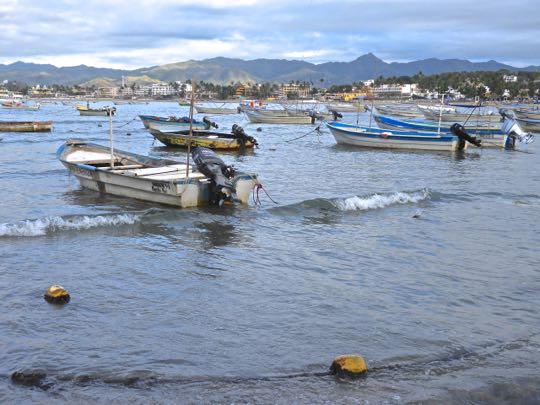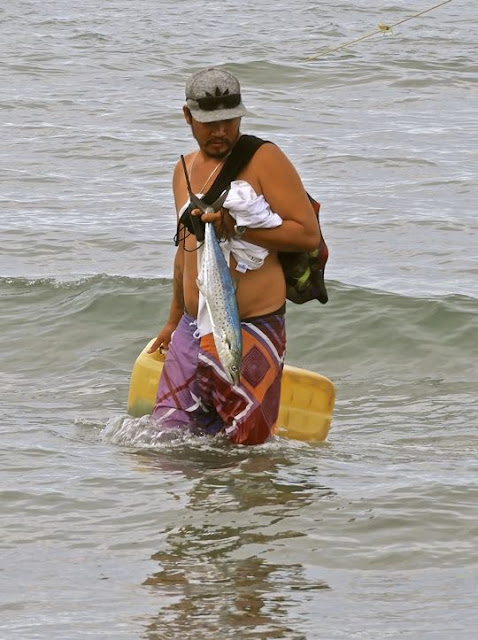In this series, we'll visit some of the smaller places that lie between Puerto Vallarta in the south and San Blas in the north. This first post will focus on Rincon de Guayabitos, (or simply Guayabitos, as it is often called). Future parts of this series will take a look at the other beach towns of Punta Mita, La Peñita de Jaltemba, and Chacala. All of these beach towns are smaller, quieter, and less overrun by foreign tourists than their better-known counterparts. Each of them is worth a visit.
Map of the coast from Puerto Vallarta to Chacala. For some unknown reason, this Google map shows Rincon de Guayabitos as Rincon de Nayarit. However, when you zoom in on Google, the correct name appears. Punta Mita is at the tip of the point extending out just north of Puerto Vallarta, near the town of Corral de Risco. The distance from Guayabitos to Punta Mita is 47km (29mi).
Overview
La Peñita de Jaltemba is not shown on the map above unless you zoom with Google. It adjoins Guayabitos just to the north. Chacala is located in a small bay at the top of the map, about 30km (18mi) north of Guayabitos. Highway #200 is the coast road that connects all these beach towns. Although the distances may appear fairly short, the highway is two-lane and winding, so traffic can be slow. However, you are on vacation so enjoy the scenery.
The mountains crowd the shore closely, leaving the Central Pacific Coast with few really long beaches. Instead, the coast is a series of bays and coves of various sizes, separated by steep points of land that extend out into the ocean. This separates and isolates the beach towns, providing each place with a sense of uniqueness.
Fishing boats rock gently in the southern end of the bay. Local fishermen sell their catch to Guayabitos' many restaurants. This means that fresh fish is on the menu almost everywhere. I took this photo at the rincón ("corner") where the shore turns sharply to the west, ending in the point of land that defines the southern boundary of the bay.
A Mexican family lounges under beach umbrellas. In the background stands Hotel Torre Blanca, one of the town's more upscale hotels. However, there is a wide variety of accommodations in Guayabitos, suitable for almost any budget.
Rincon de Guayabitos is Spanish for "Corner of the Small Guava Trees". Most of the developed part of the town extends inland for several blocks from the shore. The southern end begins at the rincón, and runs north along the coast for a couple of kilometers to the point of land that separates Guayabitos from its close neighbor, La Peñita de Jaltemba.
A stroll along the beach
Carole and I stayed at the mid-range Hotel Costa Alegre, a very comfortable "all-inclusive" place, popular with Mexican families. Like the Torre Blanca, our hotel overlooked the beach and we had a third floor room in the center with an expansive view of the bay.
Beach vendors are popular with both people and pelicans. Brown pelicans have learned that they can often grab a quick snack without the trouble of diving for fish. They seem quite unconcerned with their close proximity to the human customers.
Although I have occasionally seen a pelican try to steal a bit of food from an unwary vendor, usually the big birds wait politely for their handouts. They will, however, freely squabble among themselves. Brown pelicans are among the more entertaining creatures you will encounter along the coast.
When threatened by a predator, it inflates its body which causes the sharp spines to point out in all directions. These are defensive mechanisms to ward off dorados, sharks, wahoos and other predators. In addition to being sharp, the spines can contain a potent neurotoxin called tetrodotoxin. We kept a respectful distance.
A Brown Pelican looks me over with a rather disapproving eye. They are graceful while soaring through the air or paddling over the water's surface. On land these pelicans are comical, often reminding me of Charlie Chaplin as they waddle about. They will often flap their wings, squawk. and push aside other pelicans to get at a tidbit of food.
Watching the shore Birds watch us
Pelecanus occidentalis can be found on Mexico's Pacific, Atlantic, and Gulf Coasts. The one above appears to be a juvenile because it lacks the white or yellowish head that adults have. Brown Pelicans are resident (nonmigratory) birds who are very gregarious and like living in flocks. When feeding, they glide along in the air just above the water. Upon spotting a fish, they will go through a complicated set of aerial maneuvers to gain altitude and then dive straight down into the water.
A Snowy Egret stands in the shallows with a small fish in its beak. I have often seen these birds (Egretta thula) fishing in the shallows of Lake Chapala, near where I live. However, they can most often be found along the seashore. While hunting for prey, the Snowy Egret will wade slowly and cautiously in a few inches of water. Suddenly, the bird's neck will stretch out and its sharp bill will dart into the water. Quite often they are successful, like this one.
The Egret will maneuver the fish in its beak into position, then throw back its head and swallow. I once saw an Egret try to do this with a small snake. While attempting the usual maneuver, the Egret was surprised to find that the snake had wrapped its body tightly around the bird's bill. The snake couldn't get away, but the Egret couldn't swallow it, creating a classic Mexican Standoff! I had to move along, so I never found out who won.
The Willet is one of many species of Sandpipers. These birds are found along the shore, just inland from the waves. They poke their beaks into the wet sand or mud, looking for small mollusks and other invertebrates. The Willet is migratory, breeding in the prairie provinces of Canada and the Northern US and wintering along the Pacific shore as far south as South America.
A Frigatebird glides along the beach. Also called the Man o' War, Fregata magnificens is found in tropical and subtropical waters off the Americas from northern Mexico to Peru. This one is a female, because the males have a red sac under their throats that they inflate as a display during mating season.
Frigatebirds catch prey like flying fish on the surface of the sea. At times, they may engage in the nefarious practice of kleptoparasitism--harassing other birds in order to force them to regurgitate their food. Christopher Columbus noted this practice in his journal when he visited the Cape Verde islands on his 1492 Voyage of Discovery.
Things to do
This completes the first part of my Central Coast beach series. Next time, we'll visit La Peñita de Jaltemba, just north of Guayabitos. I hope you enjoyed this posting. If so, please leave any thoughts or questions in the Comments section below, or email me directly. If you leave a question in the Comments section, please include your email address so that I can respond.
Hasta luego, Jim






















I Love Mexico for all the reasons you mention. Beautiful set of photos. Thank you for sharing and reviving some old memories.
ReplyDelete